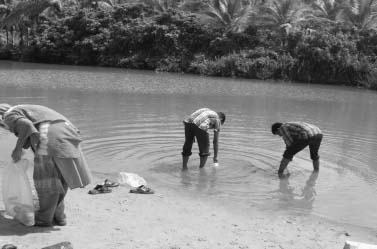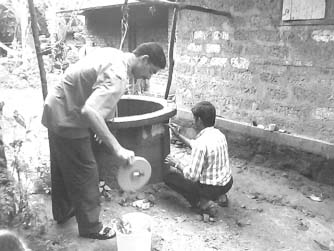 This report by the Kerala State Council for Science, Technology and Environment (KSCSTE) and Centre for Water Resources Development and Management (CWRDM) on water quality monitoring in Kerala covers all its forty four river basins. This is being done under the “Environmental Monitoring Programme on Water Quality” under which samples are being collected both from surface and groundwater sources.
This report by the Kerala State Council for Science, Technology and Environment (KSCSTE) and Centre for Water Resources Development and Management (CWRDM) on water quality monitoring in Kerala covers all its forty four river basins. This is being done under the “Environmental Monitoring Programme on Water Quality” under which samples are being collected both from surface and groundwater sources.
Groundwater sampling stations were fixed after conducting a sanitary survey in the panchayats. Water Quality Information System is being developed using Geographical Information Systems (GIS) to manage the water quality from point or non-point source of pollution.
In the first phase of the project, three river basins of Kerala viz. Kabbini, Periyar and Neyyar were monitored. The network was later expanded to basins such as Chaliyar, Kadalundi, Meenachil, Karamana, Anjarakandi, Pamba, Muvattupuzha, Bharatapuzha, and Chalakudy.
The project focuses on developing water quality and biological indices for different water bodies, which can be utilised to identify the problem areas and to suggest management action plans. Biological indicators show the degree of imbalance that has been caused while chemical methods measure the concentration of pollutants responsible. Since biota can integrate the environmental effects of water chemistry, aquatic communities like phytoplankton reflect the average ecological condition and therefore may be used as indicators of water quality. In the above context, as part of the project, biological monitoring was included.
The short, fast-flowing, monsoon-fed rivers of Kerala often encounter salinity intrusion into their lower stretches during the summer months. When the fresh water flow reduces, two major problems are seen in these water bodies: (i) salinity propagates more into the interior of the river and (ii) the flushing of the system becomes less effective. The pollution of the rivers is more severe in the downstream areas. Bacteriological contamination is one of the major water quality problems of the Kerala rivers.
summer months. When the fresh water flow reduces, two major problems are seen in these water bodies: (i) salinity propagates more into the interior of the river and (ii) the flushing of the system becomes less effective. The pollution of the rivers is more severe in the downstream areas. Bacteriological contamination is one of the major water quality problems of the Kerala rivers.
The dynamics in the structure and composition of the biota over different seasons is a key to the prevailing ecological and environmental status of the water body. The biological water quality of the water was ascertained through diversity index, Palmer’s pollution index, family biotic index and genus richness at various levels. It was observed that the streams receive stress from sewage and organic effluents. More anthropogenic impacts are reflected by the biota in river Neyyar which is a west flowing river than in Kabbini which is east flowing.
One of the major environmental problems faced by rivers of Kerala is due to the disposal of untreated municipal sewages which results in organic pollution. All the calculated indices report the organic pollution in the rivers considered. The seasonal variation in the water quality is better affirmed by a biological angle of investigation and it is proved that biotic indices like Diversity index, Palmer’s algal genus index, and family biotic index are performing more consistently in assessing the quality status of the river.
The authentic information generated by the study will facilitate the formulation of long term planning and implementation of strategies to combat the problems of poor water quality.
Download the report here -